How To Draw A Light Switch
It has taken me a petty longer than I thought, but I'm finally prepare to bear witness y'all how to wire a basic single-pole low-cal switch. But first, a few explanations and caveats.
First of all, please empathise that I'thou sharing this, along with the other few posts near electric stuff, not because I'1000 hoping you'll get out and rewire your entire house. In fact, I realize that many (probably most) of you won't actually use this information yourselves. Or if you do make up one's mind to practice some electric wiring yourselves, I'm hoping that my posts will give you the encouragement you need to understand that it's really not so hard, Only then y'all'll achieve out to a knowledgeable person who tin stand next to you while you're learning and walk y'all through the hands-on stuff until you feel comfy doing it yourself. (In compliance with local building codes, of course. Please bank check with your local building code/permit office to run across what'south permitted and required in your surface area.)
But over again, and I'll say this a thousand more times, I fully believe that an informed homeowner is an empowered homeowner. You may never wire an electrical circuit with your ain two hands, but if you sympathize how this stuff works, then you can have actual valuable input if and when you ever have an addition congenital onto your house, or if and when you ever accept a new house built from the footing up.
If you are completely uninformed when it comes to the different systems that get into your home, and you accept no thought how they work, and so yous're left completely reliant upon others to make some pretty critical decision on things that will affect your every mean solar day life in one case they pack up their tools and leave. Only if you're informed, you lot tin can give valuable input and hopefully avoid some of those decisions that would take normally been left upwardly to others, and that then get daily annoyances for you when y'all actually take to alive with those decisions.
Got information technology? 🙂 Then while electrical stuff really isn't difficult, I'k not encouraging anyone to go beyond their condolement zone here. What I am encouraging is for homeowners to be educated and knowledgeable.
And so let'due south get to the topic at hand…
How practice y'all know if you have a unmarried-pole calorie-free switch?
If you have one light switch that turns your light on and off, then that'due south a single-pole low-cal switch. That's different from three-way calorie-free switches, which you might find in large room or a room with several entrances, where the main calorie-free in the middle of the room tin can be switched on and off by two separate light switches, generally located on contrary sides of the room.
If y'all have a situation similar that, so nada here pertains to your switch. Or if you have any other configuration other than one switch turning a low-cal off and on, then nothing hither pertains to your state of affairs.
Just this would pertain to situations where you have one unmarried light switch that turns on two or more lights that are daisy chained together, like the ten recessed lights in my studio that all plough on with the flip of one single lite switch.
And then now nosotros've established if you accept a single-pole light switch. But even if you exercise, this information in this mail still might not pertain to your switch because there are 2 ways to wire single-pole switches and lights.
Practise you have a switch leg?
What I'm going to show you in this mail is the easiest and (in my humble opinion) the most streamlined fashion of wiring a switch to a light fixture. But there is another way — what seems to be an onetime schoolhouse style of doing things — that is often seen in older homes. This other (and more than complicated) way of doing things uses what'southward called a switch leg. With this configuration, the wire from the power source comes into the junction box where the light is installed , and so a "switch leg" goes from the light to the light switch.
I'yard not going to get into the details of how that'due south wired. It over-complicates things, and I never wire switches and lights that way. But, you do demand to know if your switches and lights are wired this way earlier you even do so much as swap out a calorie-free fixture or install a ceiling fan .
Yous can decide if you have a switch leg in a couple of ways:
- Plough the circuit breaker off to the room you're working in, and remove the canopy from your low-cal fixture until the wires are exposed and clearly visible. If y'all come across but iii conductors coming from the ceiling (i.e., a blackness/hot, a white/neutral, and a bare/ground), and so y'all Do NOT have a switch leg, and this postal service pertains to your wiring.
- Turn the lite switch (not the circuit billow, but the calorie-free switch) to the "off" position, and remove the canopy from your low-cal fixture until ALL of the wires are exposed. DO NOT Bear upon THE WIRES! Use a circuit tester to test ALL of the wires in the junction box. If none of the wires have power with the light switch turned off, then yous Practise Non have a switch leg, and this post pertains to your wiring. If ane of the wires has power fifty-fifty with the light switch turned off, then you Exercise have a switch leg, and this post does not pertain to your wiring.
And then now nosotros've determined if you accept a single-pole switch, and if you have a switch leg. If the answers to those are yeah, and no (in that order), then permit'southward get to the actual wiring, shall we?
Earlier doing annihilation electric, be sure that you plow off the circuit breaker for the circuit you're dealing with!! You'll ofttimes run across electricians working with live wires, merely do every bit I say and not equally they do. Plow off the power beginning.
Basic wiring for a single-pole light switch and light
Before I testify you how I wired my specific light switches, I want to bear witness yous a drawing that I did showing what a basic switch and light configuration looks like. Please note that I'm only showing the black (hot) and white (neutral) conductors in this drawing, and not the ground wire. But of form, the ground wire would follow the same path.
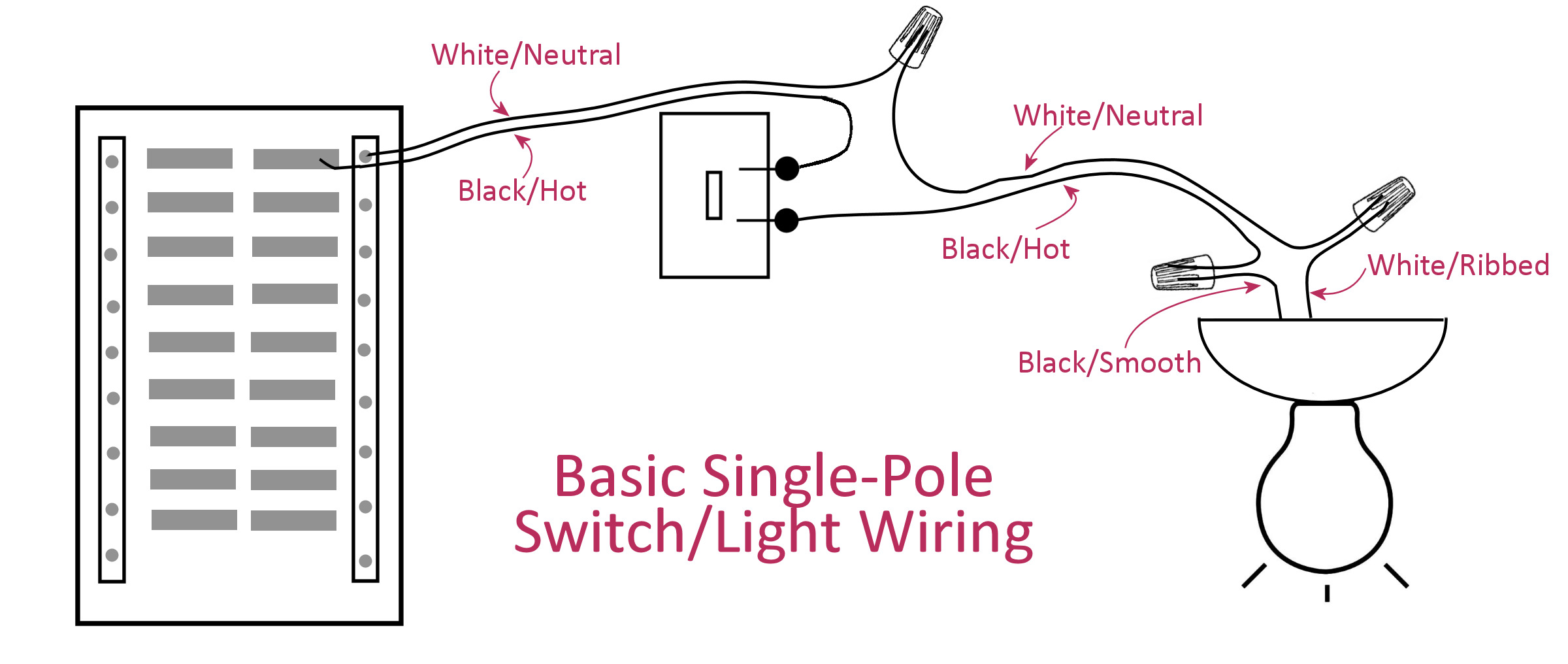
So very basically, y'all have a 12/2 or xiv/2 wire coming from your breaker box and to the junction box where your light switch will exist installed. From at that place, y'all have some other 12/2 or xiv/ii wire going from that light switch junction box to the junction box where your light fixture volition be installed.
Side note: 12/2 merely means that the conductors are 12-gauge wire, and within the outer capsule, there are two conductors (i.e., a blackness/hot and a white/neutral) plus a ground wire. 14/2 means that the conductors are 14-gauge wire, and inside the outer capsule, at that place are 2 conductors (i.east., a black/hot and a white/neutral) plus a ground wire.
Within the light switch junction box, the ii blackness (hot) wires become attached to the screws on the light switch. The ii white wires go fastened together with a wire nut. And so at the low-cal junction box, the two black wires (or the blackness from the ceiling and the smooth/solid color wire on the light fixture) get attached together with a wire nut, and the 2 white wires (or the white wire from the ceiling and the ribbed/striped wire on the lite fixture) get fastened together with a wire nut.
And that's it. It's really that elementary.
So simply for clarity, y'all can see from the cartoon that the black/hot and white/neutral conductors grade a consummate circuit. The electricity flows from the breaker box through the black/hot wires, and and then returns through the white/neutral wires. Information technology'due south a complete loop, or circuit. If you have a intermission in that circuit at any point, yous will lose power. And that'southward the basic concept backside a light switch. In the off position, it breaks the continuous flow of electricity in that loop or excursion, causing the light to turn off.
I'm explaining this, because in one case you understand the basic concepts, it's so much easier to effigy out how to do dissimilar things. Unlike my very simplified drawing above, y'all'll almost never find a real life situation where the only thing on a circuit is one unmarried calorie-free switch.
Yous'll almost ever take a state of affairs where the calorie-free switch is in the middle of a circuit. Or you might need to wire two light switches in one box in the centre of a circuit. Or you lot might take a light switch already wired, simply want to add together an outlet on that aforementioned wall. Or maybe you're wiring a iv-gang box that volition take three light switches and one outlet.
Then having a full general agreement of how, why and when the electricity flows through the different conductors will help you tackle any of those situations.
And then let's move on to my detail switch, which isn't quite as simple and clear cutting equally my drawing above since I have several outlets and switches on the same circuit. Only hopefully this will assistance you empathise some basic concepts a flake more.
Wiring a single light switch in the eye of a circuit
In this first example, I'll be wiring a one-gang junction box that holds i single switch, and that switch controls ane unmarried pendant light. And this switch is pretty much right smack dab in the center of the excursion, with two switches earlier it, and a few outlets after information technology in the circuit.
Inside my junction box, I have a black, white and basis wire that are coming from the power source (power in). I accept some other black, white and ground wire that are going from this box and feeding power to the next junction box (where there is an outlet) in this excursion. Then I take another black, white and ground wire that become from this box to the light fixture on the ceiling.
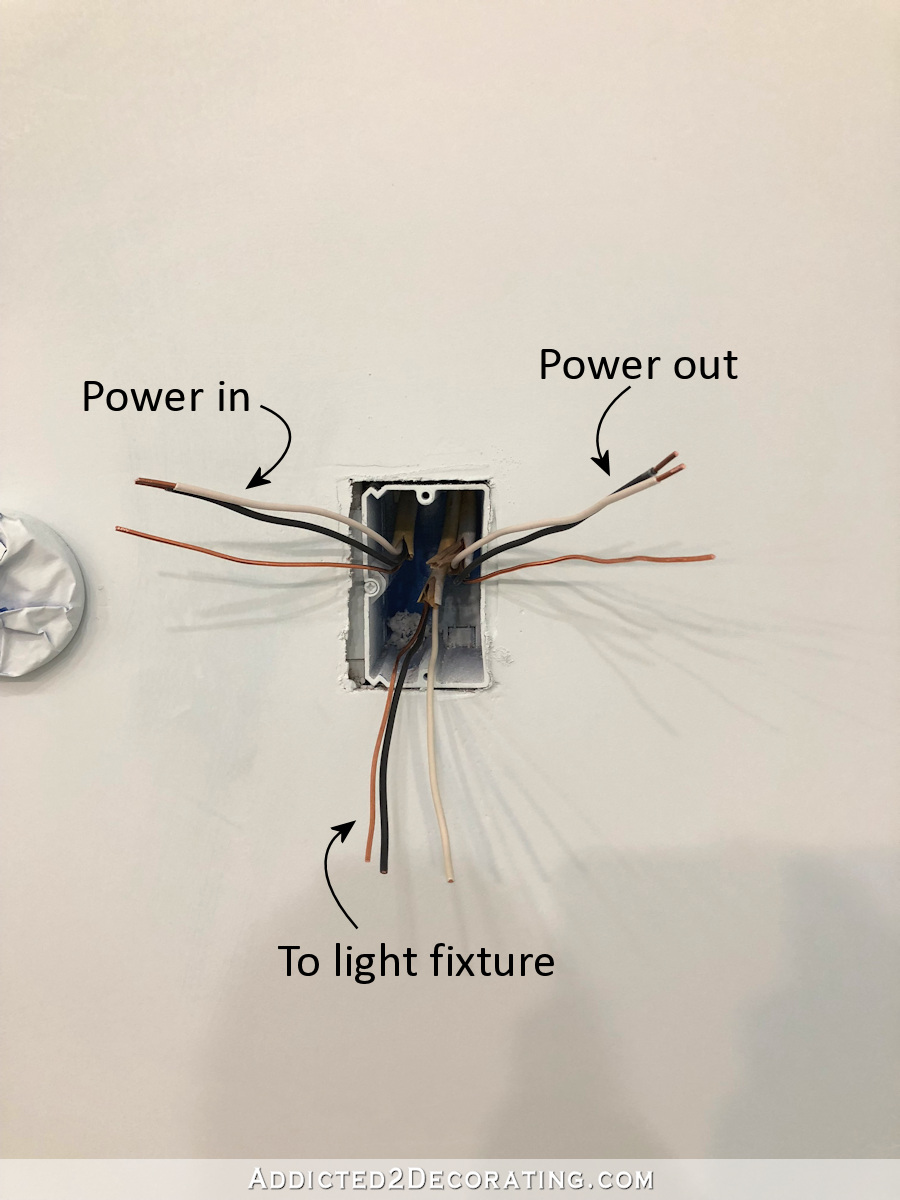
Earlier I took that picture, I had already stripped the yellow sheathing off of the wires, and cutting the exposed conductors to half-dozen inches in length. (They demand to be at least half-dozen inches from where they sally from the yellow or white capsule, and on small boxes like this, you need at least iii inches of conductors extending from the front of the box.)
Before I even retrieve about my light switch, I need to ensure that I take an uninterrupted flow of electricity going from this junction box to the adjacent junction box in this excursion where I accept an electrical outlet. Because if the flow of electricity coming into this box is interrupted in any way before information technology tin travel to the next junction box where I have my outlet, then my outlet (and anything else that comes next in this circuit) won't accept ability.
To ensure this uninterrupted menstruation of electricity, I simply demand to connect my "power in" and "power out" conductors. I used push button-in connectors because I notice them so much easier to bargain with than wire basics, but you tin can certainly use wire basics as well. If you use wire nuts, don't actually attach the wire nuts merely nevertheless. But if you use push button-in connectors, they'll expect like this right now, with the black (hot) wires from the "power in" and the "power out" continued, and the white (neutral) wires from the "power in" and the "power out" continued, and the ground wires from the "power in" and the "power out" continued.
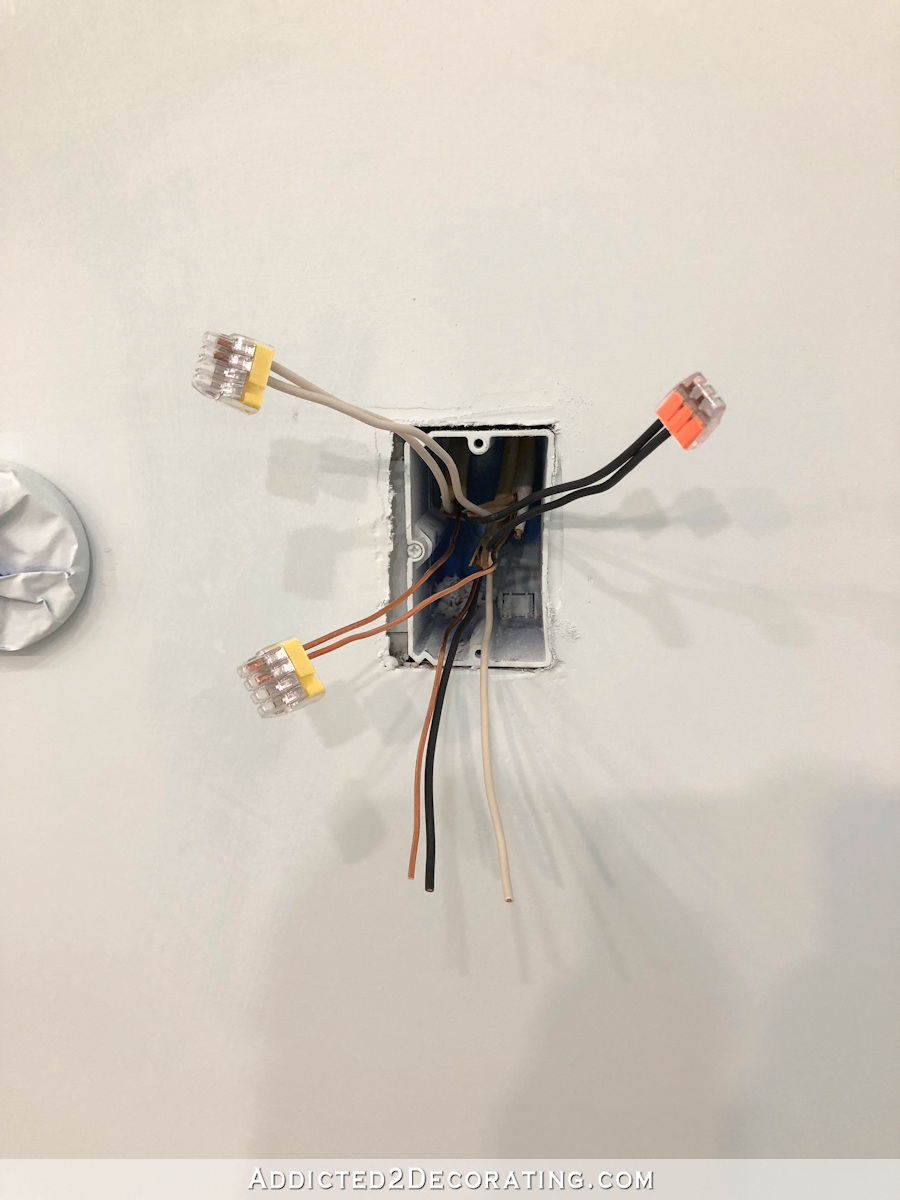
Now that I've established an uninterrupted menstruum of electricity to the adjacent item in this circuit, I tin can now focus on installing the light switch that will send power to the light fixture on the ceiling when the lite switch is turned on.
Wiring a light switch is very uncomplicated. The white (neutral) wire from the power source and the white (neutral) wire that goes to the low-cal fixture get connected to each other. The blackness (hot) wires are what get continued to the light switch.

Over again, alibi my paint-covered hands. I paint a trivial and so work on electrical. And then paint a footling, and and then work on something else. 🙂
So dorsum to the junction box. At this signal, I have the "power in" and the "power out" conductors all connected, leaving the hot, neutral and ground that become from the junction box to the light fixture.

The ground wire that goes to the calorie-free fixture needs to be connected to the other ground wires…

And and then the white (neutral) wire that goes to the light fixture needs to exist connected to the other neutral wires…

That leaves me with 1 black (hot) wire that goes from the junction box to the light fixture. But remember, for the calorie-free switch, we need one black wire coming from the ability source to the lite switch, and i black wire going from the light switch to the light fixture. Nosotros besides need a ground wire connecting the light switch to the other ground wires.
To achieve this, I cut two pigtails, which are simply short lengths of conductors (6 inches) that connect one matter to another inside a junction box. I connect a black pigtail to the other blackness wires that take already been connected, and I connect a bare (ground) pigtail to the other ground wires.
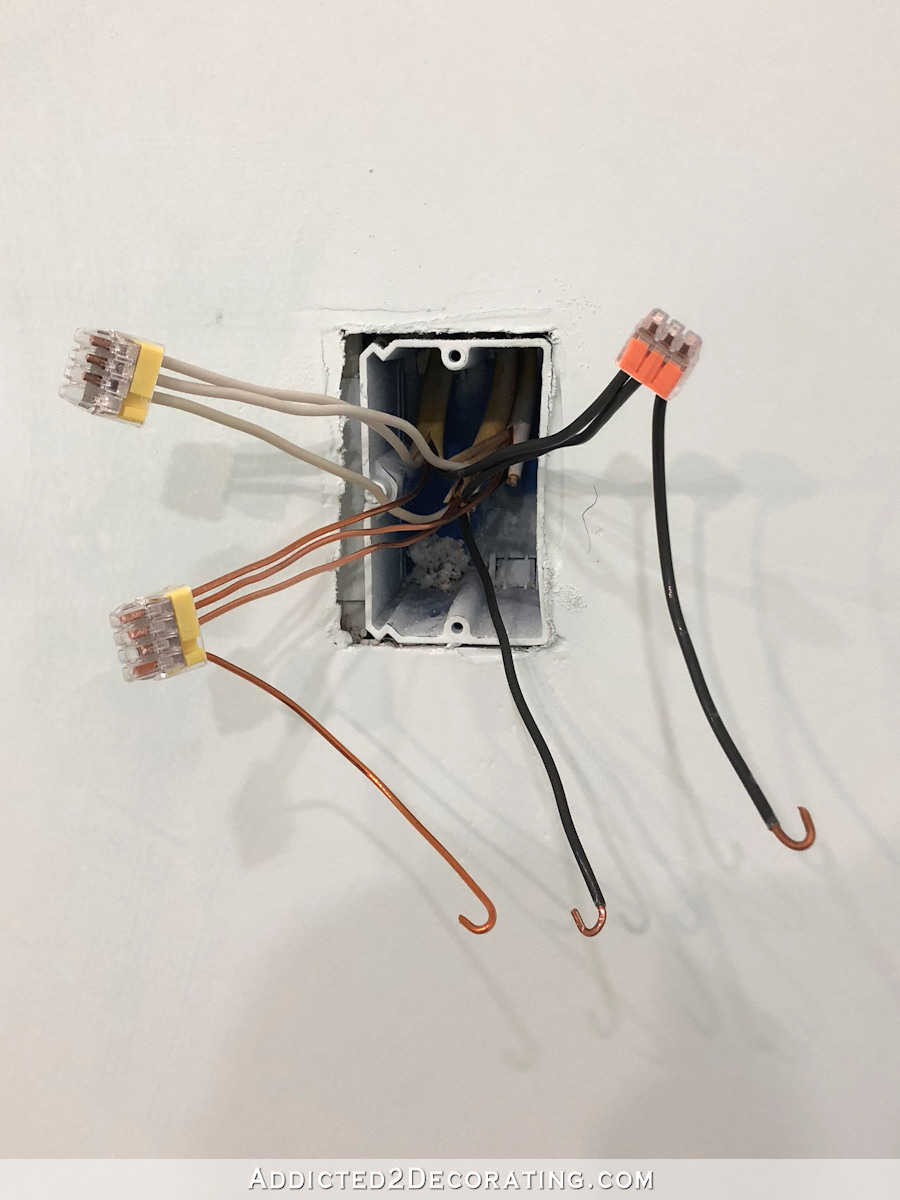
And with that, I have everything I need to connect the low-cal switch — a black (hot) wire feeding power to the switch, a black (hot) wire sending power to the calorie-free fixture, and a ground wire.
To connect the conductors to the light switch, I stripped the ends the specified corporeality according to the strip gauge on the dorsum of the lite switch, and and so used my pliers to create a hook in the ends. And then I wrapped those clockwise around the final screws so that they reached three/4 of the way around the screw, and tightened the screws. I put the one bringing power into the light switch on the lesser, and the 1 sending ability to the low-cal fixture on the acme.
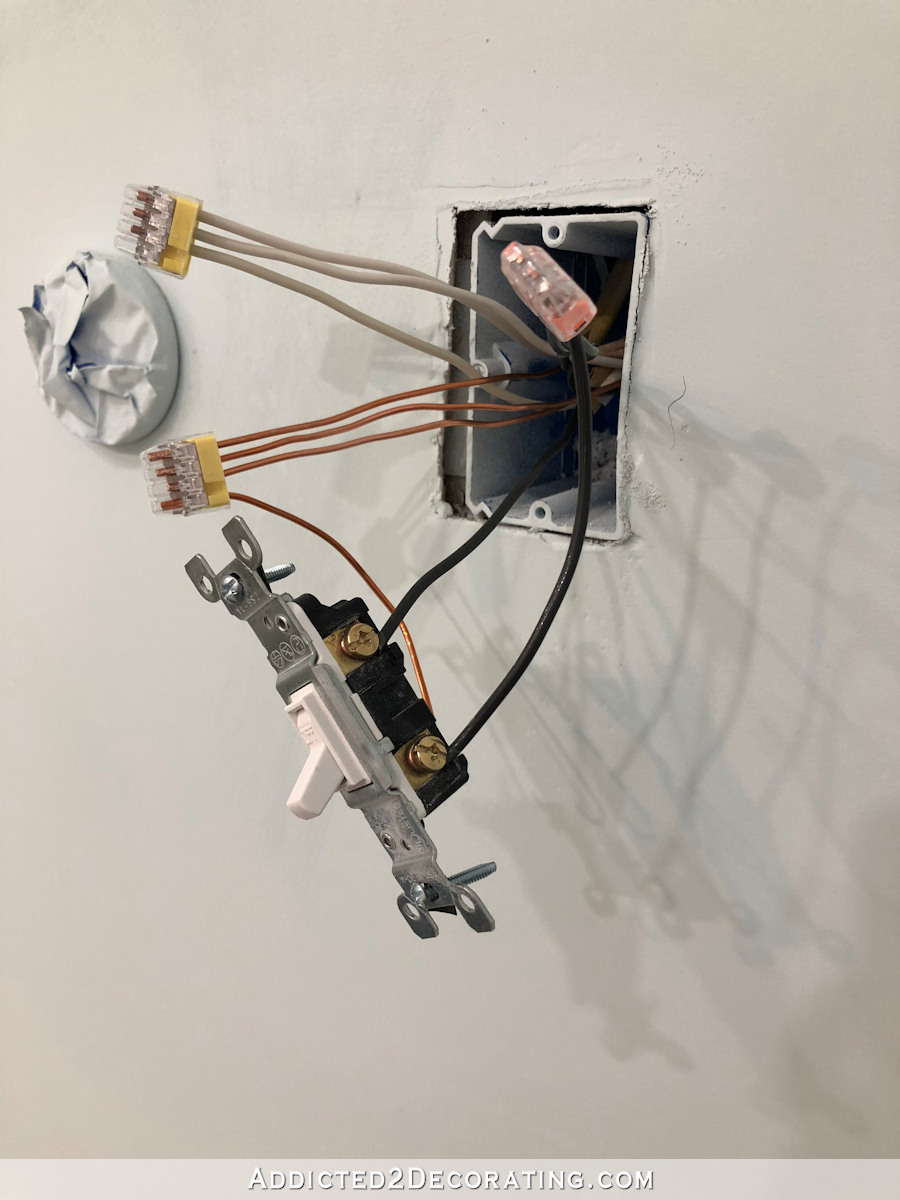
And then I hooked the end of the ground wire, wrapped it around the green screw clockwise so that it reaches 3/4 of the way around the screw, and tightened.
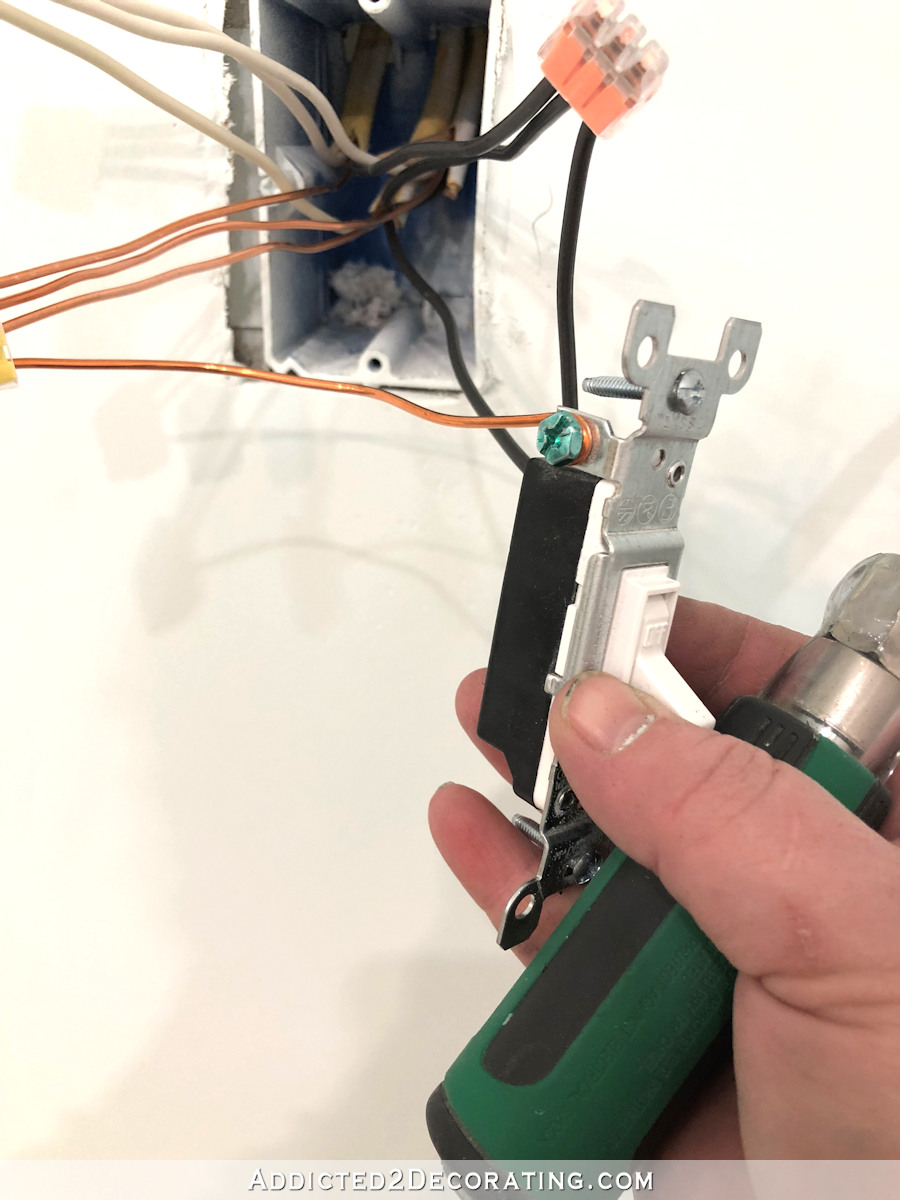
And with that, the light switch is ready to be screwed onto the junction box.

Information technology takes a little patience, peculiarly when dealing with 12-approximate wires, to get those things wrestled into the box. You just have to be business firm simply careful that you don't damage anything, and once the switch is screwed onto the box, exist sure that naught is touching the screws
Does information technology all make sense? Let me interruption it down very simply:
- You demand an uninterrupted flow of electricity coming into the box then going to the next item (a switch or outlet) in the excursion. To do this, the "power in" and the "power out" conductors need to be connected.
- Then you demand to feed ability to the switch which will turn the calorie-free fixture on and off. To do this, the white (neutral) conductors from the "power in" and the "to the calorie-free fixture" wires need to exist connected to each other. Then the black (hot) conductors from the "power in" and the "to the lite fixture" wires demand to be connected to the light switch.
- And finally, the lite switch needs to exist grounded.
Wiring two switches in 1 box in the middle of a circuit
Now I'll show you how to wire two light switches in the same box (i.eastward., a two-gang box). And once again, these switches are located in the middle of a circuit. And then just keeping the same concepts in heed, this is what we need to do:
- Establish our uninterrupted flow of electricity from this box to the next item (switch or outlet) in this circuit.
- Then from that power coming into the box, feed ability to each light switch.
- From those light switches, feed power to each light fixture.
That'southward the basic concept, and so let me bear witness you step-by-step only how I did that.
I started with these four wires coming into the box. From left to correct, I have power in, power out, to the ceiling light, and to the wall (vanity) calorie-free.
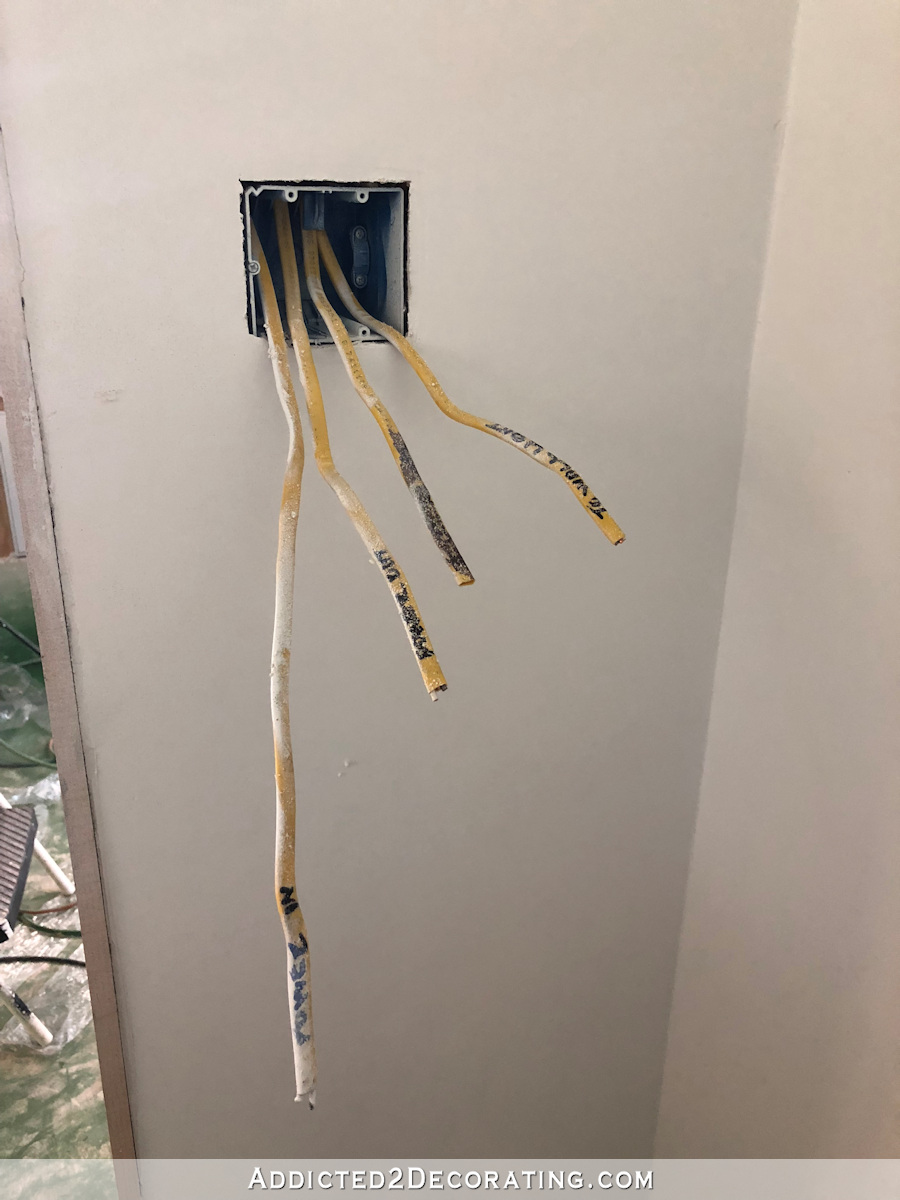
Starting time, I strip the yellow capsule from the conductors…
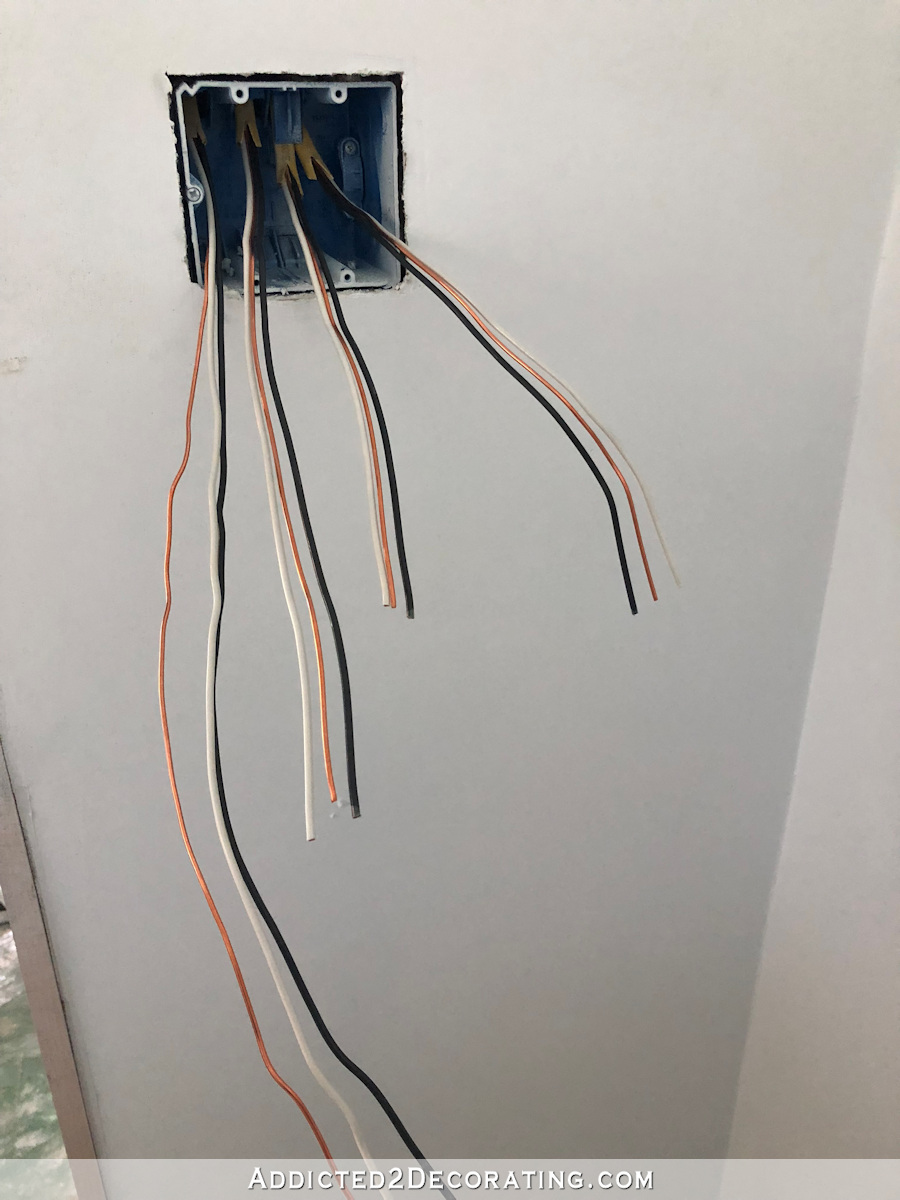
Then I cut the conductors to length. They demand to be at least vi inches from the bespeak where they emerge from the sheathing, and there needs to be at least 3 inches of conductors extending past the front of the box.
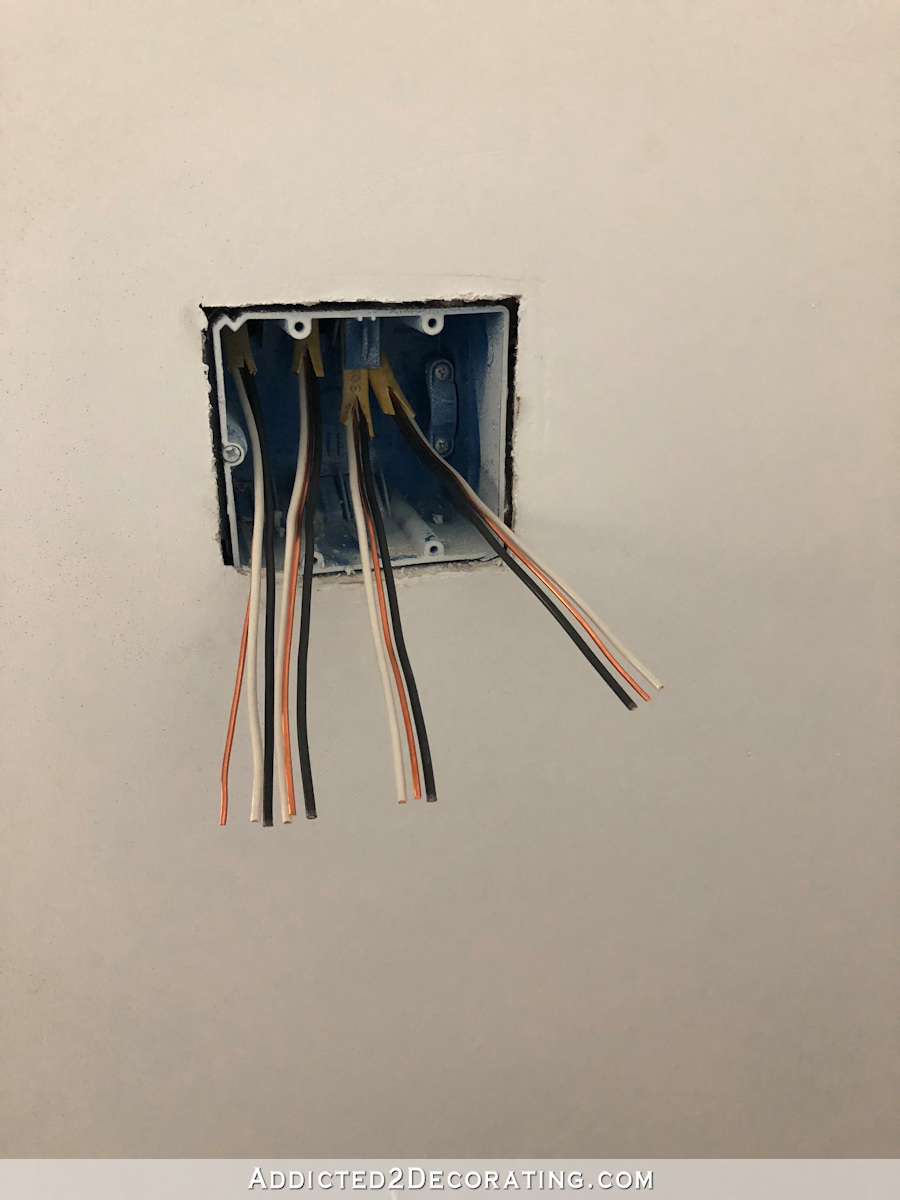
Before fifty-fifty dealing with the switches, I commencement need to establish my uninterrupted catamenia of electricity from this junction box to the next junction box in the circuit. I do this by connecting the white (neutral) wires from the "ability in" and the "power out." Then I connect the black (hot) wires from the "power in" and the "power out." And finally, I connect the blank (ground) wires from the "power in" and the "power out."
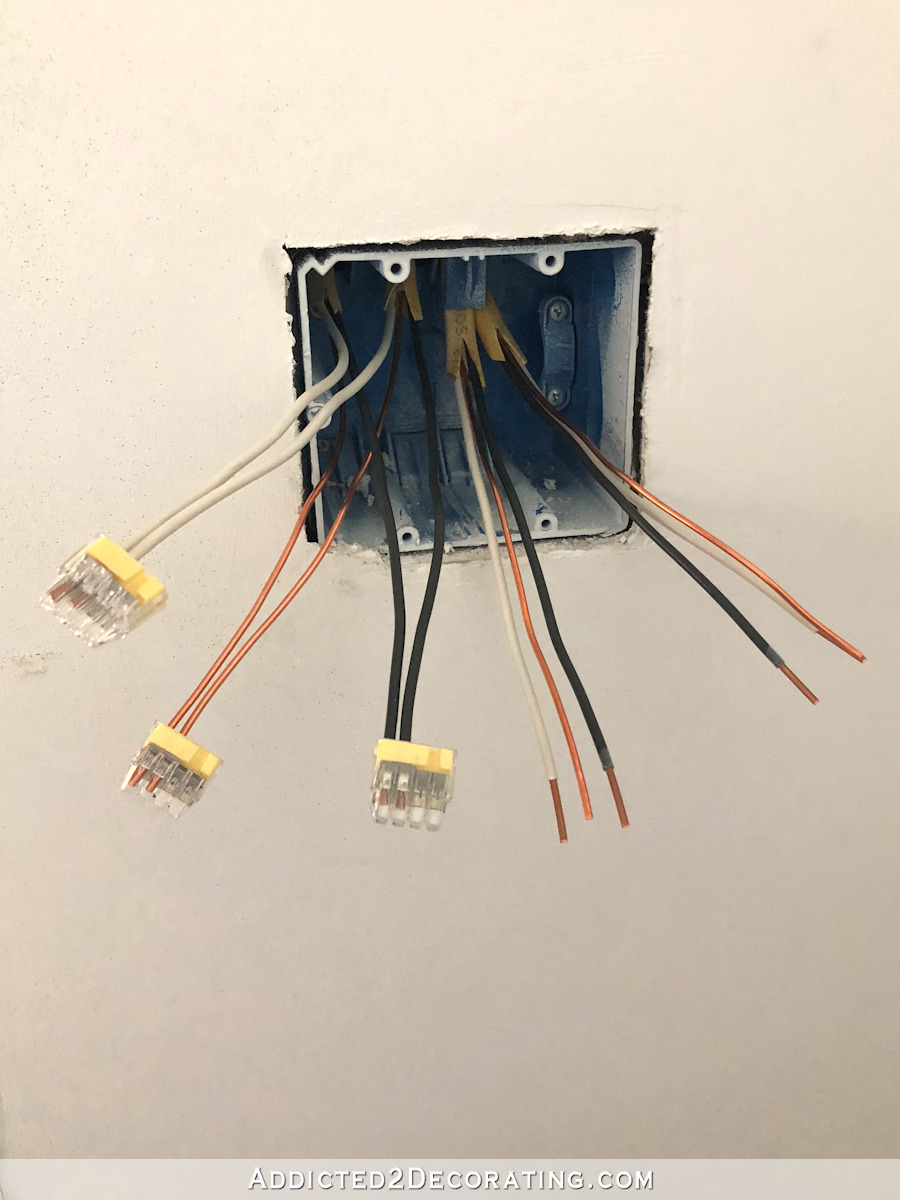
Now that I've established that uninterrupted flow of electricity to the adjacent junction box, I tin plow my attention to the switches and the wires that become to the bodily lite fixtures.
The first thing I do is connect the white (neutral) wires that get the low-cal fixtures to the other white wires.

That leaves me with two black (hot) wires — 1 wire that goes to each light fixture. But remember that each switch requires two blacks — one bringing ability in, and 1 sending power to the low-cal fixture. Right at present, we simply have the ones sending power to the light fixtures.
So to remedy that, I cutting two black pigtails that are 6 inches long…

…and I connect those black pigtails to the blackness conductors that are already connected…
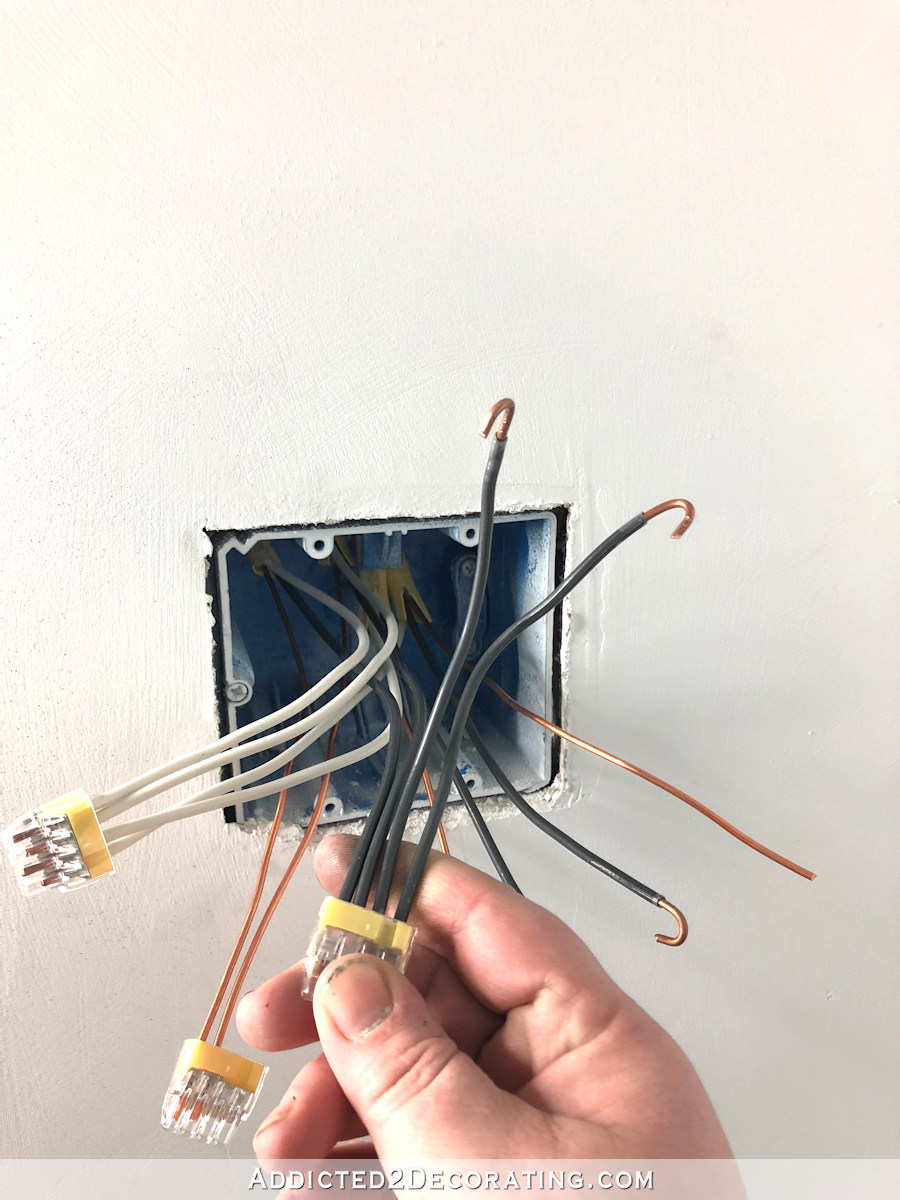
I now have what I need to bring power into the switches, then I connect one pigtail to the lesser screw on each of the switches.
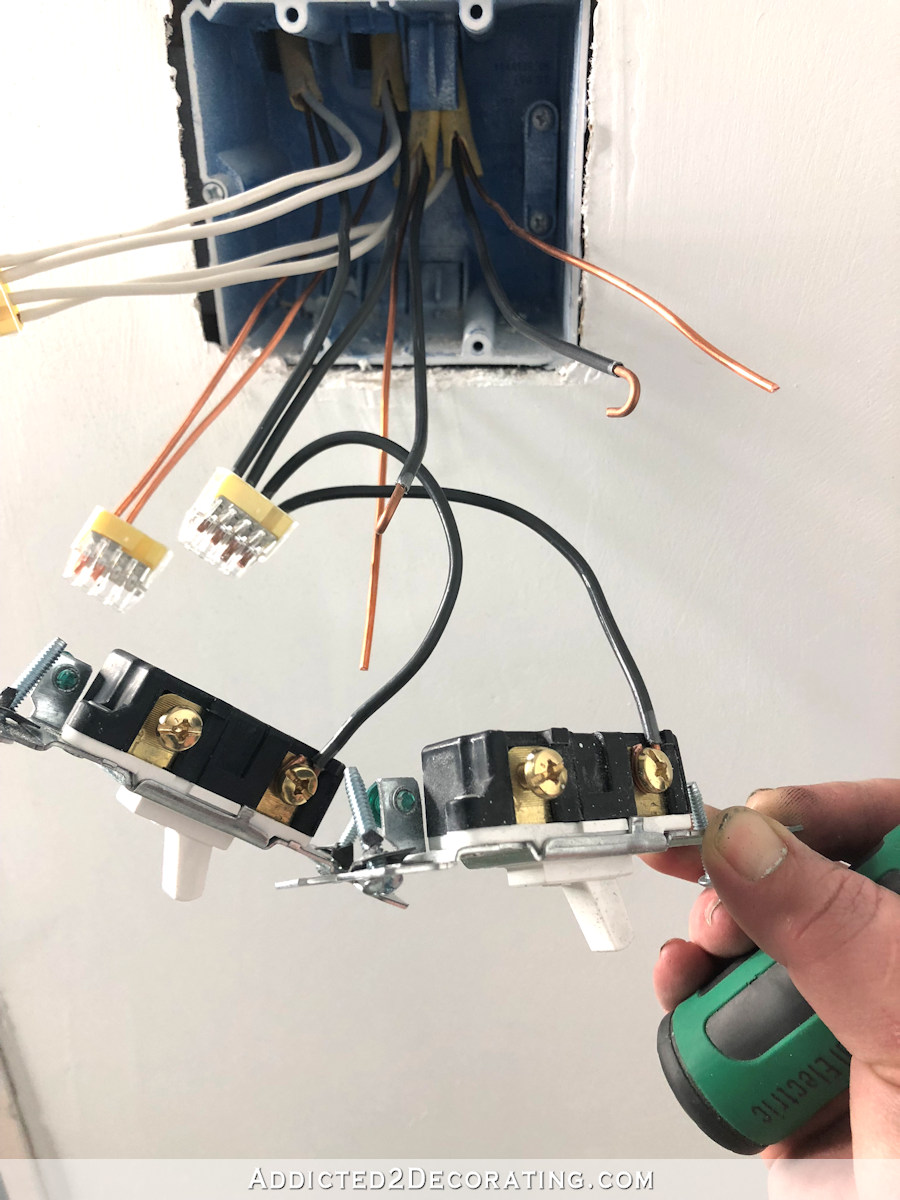
I've now established ability into the switches, and then I need to transport power from the switches to the light fixtures. And so I connect the other two black wires to the top screws on the light switches.

So at this point, my neutral wires are all connected, and I have power in (from the power source) and power out (to the light fixtures) on each switch. But the switches still need to be grounded. I have the two ground wires that become to each light fixture, and only two more slots in my connector.

But I need infinite for 4 more than ground wires, because I accept the two that go to the light fixtures, and then I demand two for the light switches (1 for each switch). And then I get ahead and connect one of the remaining ground wires to the connector…
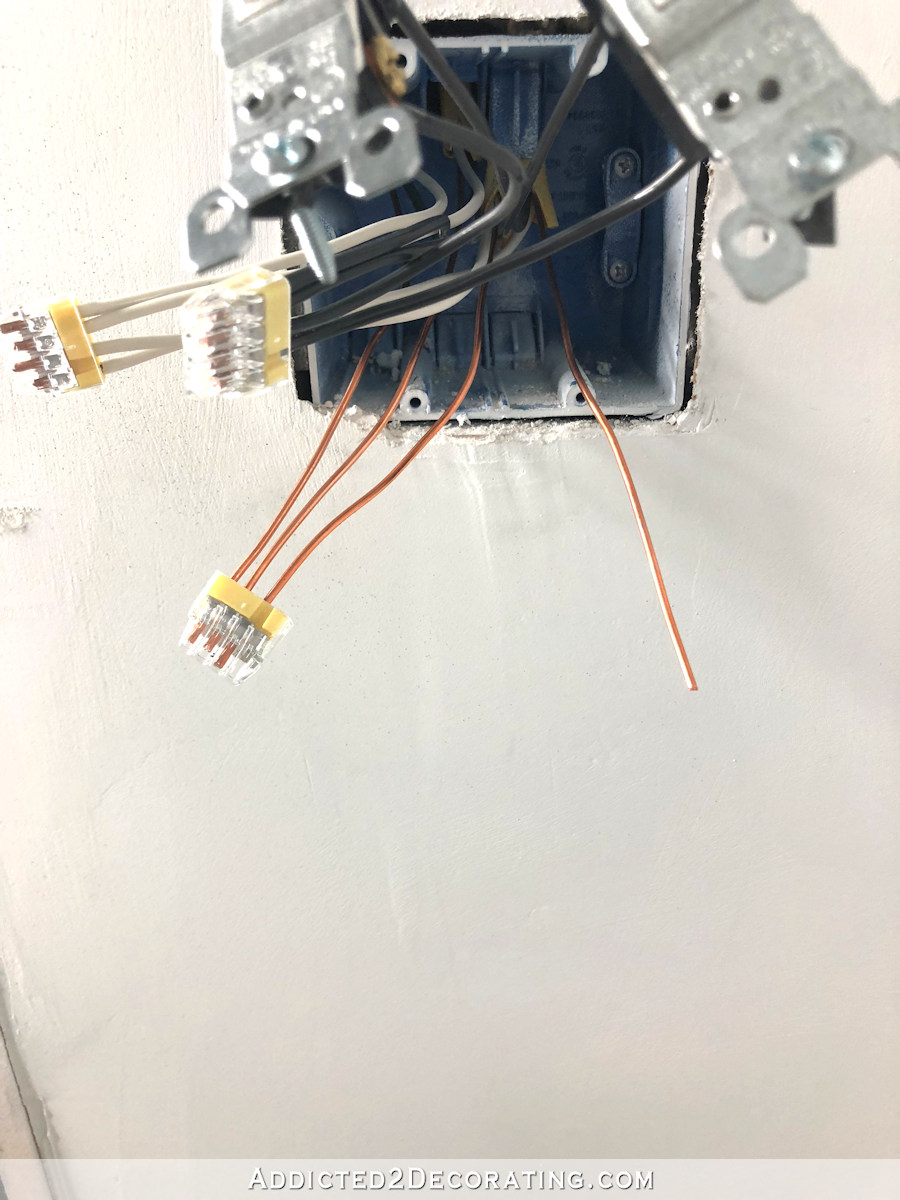
But then I demand to cut a pigtail to human activity as a jumper from this connector to another connector to make room for the other neutral wires.

And then after using that pigtail as a jumper from i connector to another, it looks like this…

At present obviously, if you lot're using wire basics, you don't need a pigtail to act every bit a jumper. Y'all'd just connect them all together and make sure you lot use an appropriately-sized wire nut to connect all of those wires together. Merely since I'm using button-in connectors, and there are only so many slots in each connector, I have to use a pigtail as a jumper.
And with the 2 now connected, I can add the residual of the ground wires I need to the second connector. I start by calculation the other ground wire that goes to the 2d light fixture…

Simply I still need to basis the actual low-cal switches. I practise this by cutting two blank wire pigtails that are six inches long…

I put those into the connector…

Then attach 1 footing wire to each of the light switches.

And voila! Done!
Then I just have to coax those wires into the box, carefully but firmly, spiral the light switches to the box, and make sure that nothing is touching the screws on the sides of the switches.
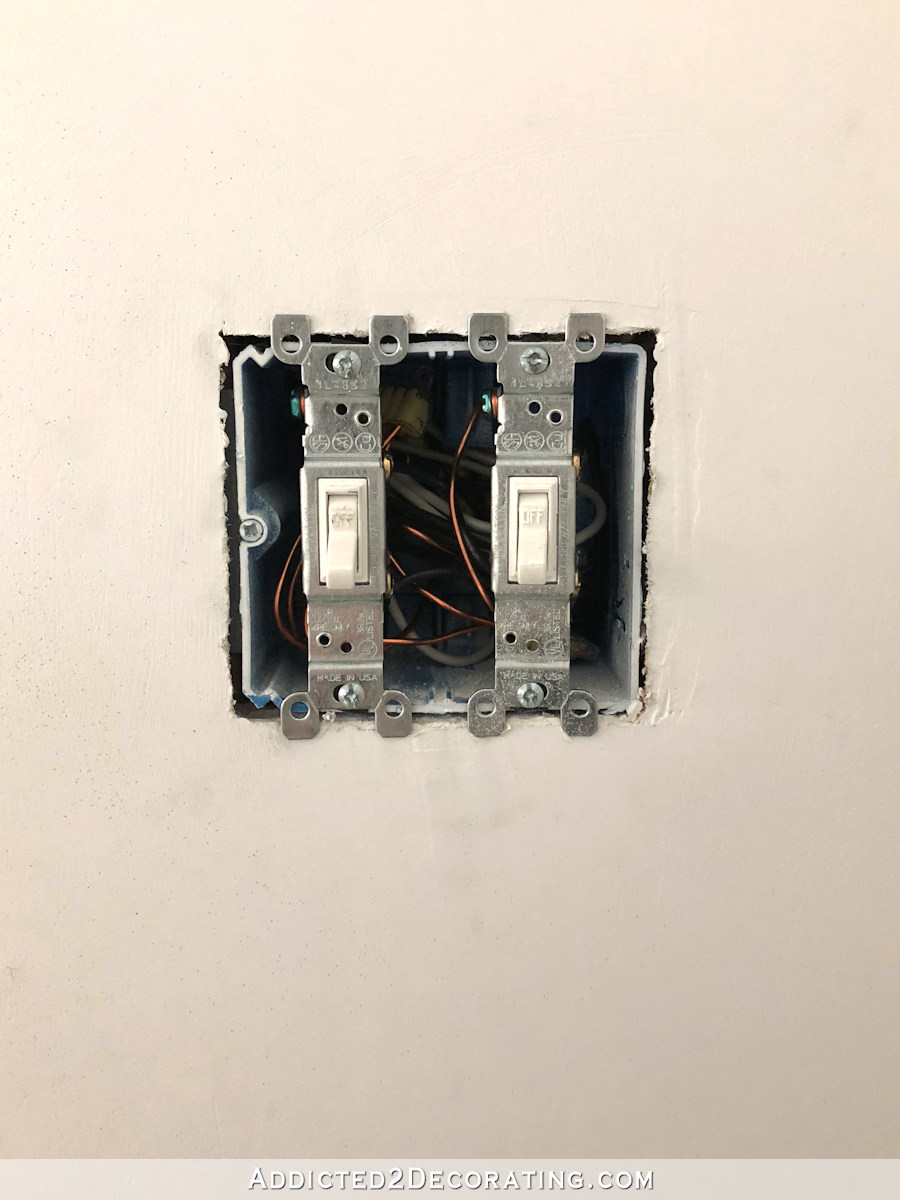
To wrap upwardly…
I know this was long, but I promise information technology helped some. I know when my father-in-law came to town and we (or rather, he) wired the living room, I was so lost. I have a iv-gang box with four low-cal switches just inside my front door, and for the life of me, I couldn't figure out how he had wired all of those then that each light switched off and on like it should, while the electrical outlet that was down the line on that circuit still had power all the fourth dimension.
Y'all, information technology took me forever to understand it. I felt like I had a complete mental block. But then i day, I finally got it. Everything but clicked in my mind, and I finally understood.
I finally understood that first, earlier wiring whatsoever of the switches, you have to establish uninterrupted power from the junction box that you're working on, to the next junction box in that circuit, whether it'due south an outlet or another switch. And then later on you've washed that, you have to bring power into each calorie-free switch, and then send power from each switch to each light.
Once the concept was simplified in my heed, I was able to wire up just about any configuration I came across — a four-gang box with all switches, a iii-gang box with ii calorie-free switches and one outlet, and on, and on.
I'thou telling yous. A knowledgeable homeowner is an empowered homeowner, whether you use that knowledge to do the work yourself, or whether you use that knowledge to give valuable input to your electrician as to how you lot desire things done that volition affect your daily life for years to come.

Addicted 2 Decorating is where I share my DIY and decorating journey every bit I remodel and decorate the 1948 fixer upper that my married man, Matt, and I bought in 2022. Matt has G.South. and is unable to exercise physical work, so I practise the majority of the work on the house by myself. You can learn more about me here.
I hope you'll join me on my DIY and decorating journey! If you lot desire to follow my projects and progress, you can subscribe beneath and have each new mail delivered to your email inbox. That way you lot'll never miss a affair!
Source: https://www.addicted2decorating.com/how-to-wire-single-pole-light-switch.html
Posted by: kennedyweds2000.blogspot.com


0 Response to "How To Draw A Light Switch"
Post a Comment